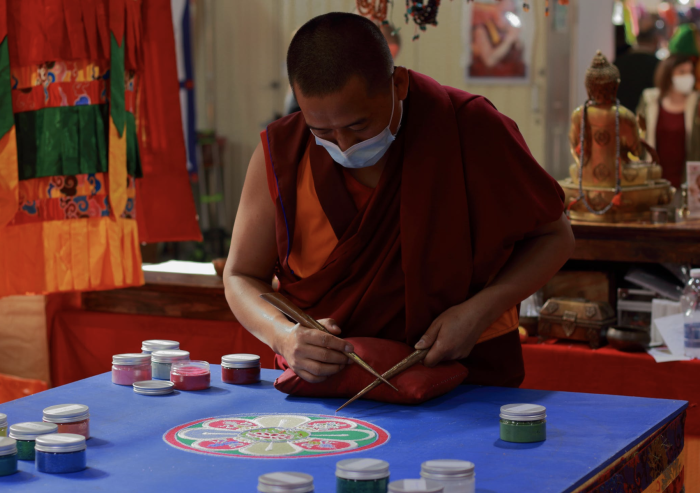Six years ago, during my visit to the land of authenticity and nature—Nepal—my guide for the day took me to an art school where mandalas were being painted and sold.
I was drawn to the refinement of their work, to the precision of their brush, and the variety of colors they used.
A mandala is a spiritual symbol in Buddhism representing the universe. Painting a mandala is one thing, building it with dyed sand is another.
Starting from the center, while mumbling a mantra and dancing, monks use dyed sand to create elaborate patterns. They spend hours and days fabricating it perfectly and precisely—pouring their love and energy into every curve.
Once the mandala is complete, one chanting monk will begin the destruction of the mandala by drawing lines from the perimeter to the center with his own hands and gathering all the sand using a paintbrush.
This ceremony is done as a reminder of the impermanence of life.
Why destroy a work of art that took a lot of effort and time, and was built with pure intentions?
The question struck my being in every possible way. Butterflies tickled my stomach. I automatically rejected the perception since everything I did was the complete opposite.
Knowing first that even though Buddhism is just a philosophy and not related to any kind of religion, mandalas weren’t and aren’t my playground anyway. This didn’t wipe out the fact that it made me ponder.
Every time I met people, I made sure to build a permanent relationship that would last until I took my last breath—to my understanding, at that time, humans lived and stayed forever.
The first job I took as an official adult ready to conquer the world was a career that would not perish, as per my analysis.
Some of my childhood writings are still hidden, not only in the darkest parts of my head, but in a well-organized and neat cupboard—only my egghead knows the code to its lock.
There’s a 15-year-old painting, depicted with pure hands, hanging in front of my bed. It was a gift from a dear friend whom I met 25 years ago—a quarter of a century.
In my subconscious, life as I know it won’t ever cease to exist and my memories are the base to every situation that will happen in the near future.
My attachment to people, moments, things related to people, any emotional conflict expressed through art, and this very writing will be saved and taken care of until the end.
Temporary was out of question and planning was my ultimate weapon. Plan. Take action. If it doesn’t work, there’s always plan B, C, D, and 24 more letters in the alphabet. I would never—not one single day—stop making plans, like a cat would not abstain from exhausting her nine lives.
Theoretically, it leaves no space for uncertainty anymore. Who can bare uncertainty anyway?
Any sign that previously crossed my path and attempted to eliminate this conviction was neglected completely. I focused fiercely on seeing things as I was, and executed them the way I wanted, not the other way around. How many “I”s would I have to use, to mark my existence?
Knowing the true meaning behind a mandala is one thing, but acknowledging it is another.
The butterflies that tickled my stomach back then were a sensation manifested through outrage and judgment. Will I ever be able to destroy the writings hidden in my neat cupboard? What am I so attached to that keeps me from being able to do it?
Aren’t we all attached to simple things, unconsciously?
The sunglasses we just bought and couldn’t find at home. The book we ought to read but somehow, someway lost. The cute designer top hidden somewhere in one of the four closets of each room in the house. The phone we forgot in our car. The simple keychain, with our favorite quote written on it, is missing. Our day-off from work rescheduled until further notice.
The system’s designed to bring ease to our daily lives, or maybe to blind us all. Have you ever suffered from losing a job you really loved? Or a workaholic partner that didn’t give you enough attention? Have you suffered from a break-up? Lost possessions?
During the COVID-19 outbreak, everyone was abruptly asked to remain home and practice social distancing. Some were traumatized by the lack of normalcy; others were in complete denial. Some were having second thoughts on whether or not to physically salute the next-door-neighbor or worse, a family member sharing the same roof. Some were wearing masks and gloves. Some were paranoid if a friend they met at the supermarket didn’t spontaneously respect the distance acknowledged by the World Health Organization.
The world has changed.
It might be temporary, but it doesn’t feel that way. Some researchers mention that people are experiencing a kind of “grief” for losing a way of life that has been implemented for 100 years, since the last pandemic.
This sudden behavioral change has confused humanity. Personally, it made me accept the fact that life is impermanent, and my attachment to normalcy makes it painful to adapt to the new life ahead of us all.
Being attached to circumstances and material things is an ignorant way of living. That doesn’t mean we should give up everything and head to the Himalayas. No, this is where non-attachment comes into the picture.
Non-attachment is when we let go of control and allow everything to come and go. We are not the possessor, but a caretaker. We enjoy something’s presence, and when separation is bound to happen—we let go as if it was never meant for us.
We no longer have to become hysterical when our sister accidentally rips our favorite dress. Or when our close friend unintentionally loses our best power bank. We don’t have to be disturbed when our soul mate was, in fact, only a life lesson to learn. We can find understanding when the vacation we have been planning for ages is cancelled. We have the conviction that the idea of normalcy incarnated in our heads is, in fact, flexible and adaptable to many changes.
Practicing non-attachment does not mean renouncing family life, becoming emotionally unavailable, or being a less compassionate person; on the contrary, it’s pure, free love.
It is realizing the true nature of things; seeing them as they are, not as we are. It’s doing what needs to be done, regardless of the emotional baggage we carry. It is accepting anything’s arrival as much as its departure, and getting to know ourselves in the process.
After all, we are souls in a human body set on an individual journey; each and every one of us has a separate destination.
Today, our paths may cross, but tomorrow we could find ourselves on opposite ends. Souls go beyond the body, relationships, and circumstances.
We might as well remind ourselves constantly that nothing is in our control—not even us—and change and death are the only certainty in this whole, vast universe.
~












Read 0 comments and reply